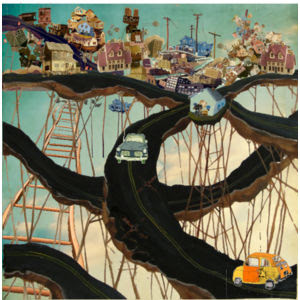ATAJ Journalism Trophy (My entry)

Zoom into the city and take a walk down the main street; you’d see a story repeat on most of the main streets. Loud hoardings trying to grab attention; extremely congested roadways with constant chaos; wall and column stubs coated with a sepia layer of spit and tobacco; air-conditioned shopping arcades, French restaurants and German coffee shops amid the odor of a market urinal surrounded by garbage and filth. Contrasting moments of sheer dereliction and overwhelming delight! It’s like a circle getting into a square, but human spirit can certainly reconcile the two extremes. After all, it is the taste of the city, the new taste of urban India.
What makes a city ugly?
A city in itself can’t be termed as ugly. It is the lack of organization that makes it visually unpleasant. It is like pitching in the wrong ingredients to make a dish. Even a minor element can ruin the look and taste of it. Therefore, since the complete change of ingredients can’t be carried out, to retain the original flavor of the dish minor amendments could renew it.
Infrastructure is no different. The Architects/planners are the sole culprits of creating disorderly havocs. They tend to overlook the context to create an extravagant structure in an attempt to build a landmark or give the city a future historic idol. It is quite surprising that we still dwell upon the already existing historic and heritage structures when we have to give our city a spot to mark on the map. Structures are replicated till it reaches to every city in a country. Anything from heritage bridges to tombs are imitated. (For Eg. The Taj Mahal, Dhaka is a sheer duplication of the one existing in India. They’ve coined it as The Taj for the poor who cannot afford to make it to India. Surprisingly, they could afford to shell out heaps of money and make one for themselves in this era! In an age where space is money and design is 3-dimensional, why mock something and lose regards.
It is not just infrastructure. In case of Chandigarh, where everything looks in place, the streets are wide and smooth with soft-scapes and hard-scapes along the pavement and the city is clean, it is still labeled as a dead-city. In this case the lack of planning makes it ugly. The architect planned the city overlooking the social and cultural backdrop of India and ended up making a city that nobody likes to live in.
The image if a city…
In Rishikesh, along the river bank two views were firmly etched into the skyline. On one side is the Hinduism’s benign skyline – a line of Ghats lapping the river edge and curvy temple silhouettes while on the other side along the main highway lay the slummy standard north-Indian town. Pink and yellow plastered buildings, incomplete pastel-shaded structures stained by monsoon, paan and urine at the base! The old historic monument can do nothing but watch this architecture tide pass.
The imageability of the city has changed, for every city would, in a couple of decade’s time, start looking the same. Culture overlooked, heritage disregarded, ethical value of the people responsible for this change, lost would make each city into a soulless pile of concrete and steel. And in this new age of development, skyscrapers are the fore-runners. If we go by definition a skyscraper is an inhabitant structure that protrudes above the built form and changes the skyline. That means, with every skyscraper, the skyline changes. Imagine what a city would look like if we have hundreds of them!
The question is, ‘What are the planners and architects of today turning the city into’? And ‘Why are things working out this way’?

Firstly, it is Green Architecture or rather a major misunderstanding of the term green architecture by architects. Every sky kissing building would be backed by terms like energy- efficient or eco friendly or green roofing for that matter. I really doubt if these terms give them the license to create structures that are amazingly hideous! An individual structure might be very efficient as a design and in use. But to juxtaposition them next to each other makes the city look highly mislaid. Architecture is composition. Even the design competitions that are circulated around the countries these days demand things that make the budding architects and planners follow the same course! For e.g. A design competition brief demanded for an innovative design to change the skyline, indirectly asking them to create a piece of art and fix it in the existing skyline such that your structure has the capacity to bring about a considerable change to it! Quite an inspiration!

Secondly, competition. The need to be the most expensive, energy efficient, technically sound, politically right architectural symbols! A living example of such a city and an epitome of being the heights of skyscrapers is Dubai. An assortment of any kind of skyscrapers that rotates, revolves or may be even flips upside down! To reach to these beauties, there are elaborate highways, crossing each other in all the ways possible making the city complicatedly ugly. We have sky-walks, for people can barely walk on streets, flyovers coz the existing streets are overcrowded and highways connecting towns to cities and cities to states. The transport route in itself has become so complicated that in the act of decongesting traffic they are congesting the city with mammoth sized columns dug on the streets.

In Mumbai, there’s a vast expanse of railways, monorail is soon to start and metros are proposed. So, there is transport underground, on the ground and over the head. Ironically, the city has been crossed a million times by its own lifelines! In a couple of decade’s time, Mumbai would hit the full moon and eventually get on water. Bridges can break into lanes and maybe we could create a “very new Bombay” city around the Bandra-Worli sea link! A whole new city floating on water, a sister city to Amsterdam who’s creating a replica underground!

Bibliography :
Books: Excerpts from Cities and their news media image.
Internet: Wikipedia , other random sites.
Personal Experiences and Interviews:
Visit to Agra, Fatehpur Sikhri, Chandigarh, Delhi, Mumbai
Interviews with commoners living in different cities (Dubai, Saudi, NewYork, Mumbai)
Image: Courtesy Google.



Comments
You are one amazing archi in the making.. :D
Nikhil
Thank You for your comments! :) :)
cheers!
psst.. how about a knock-out fictional story with architecture as the background? :P I know you can...you have it in ya..